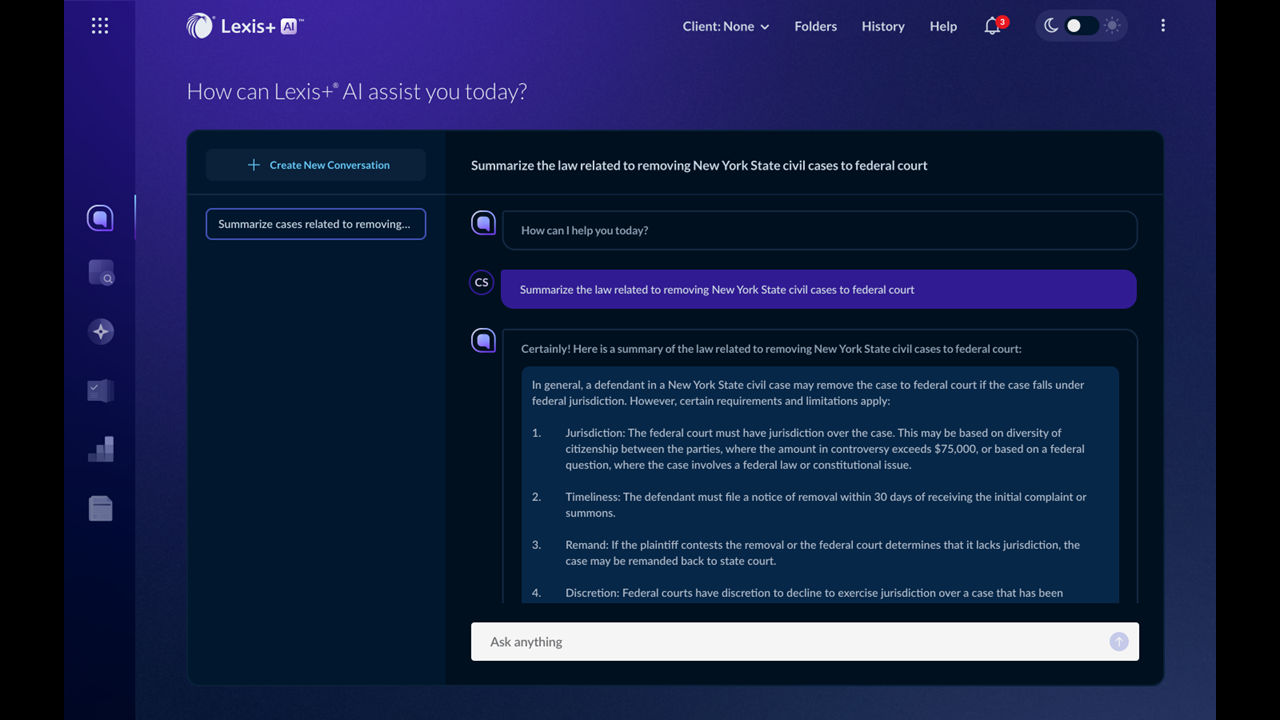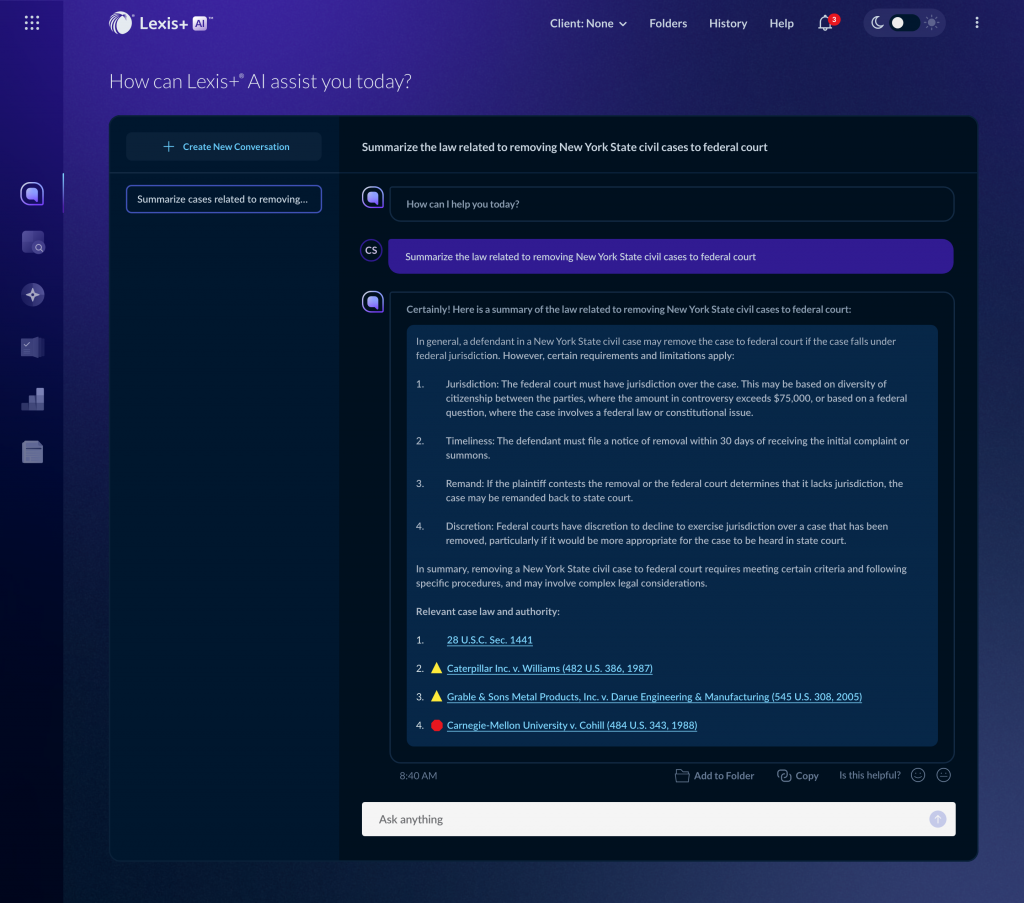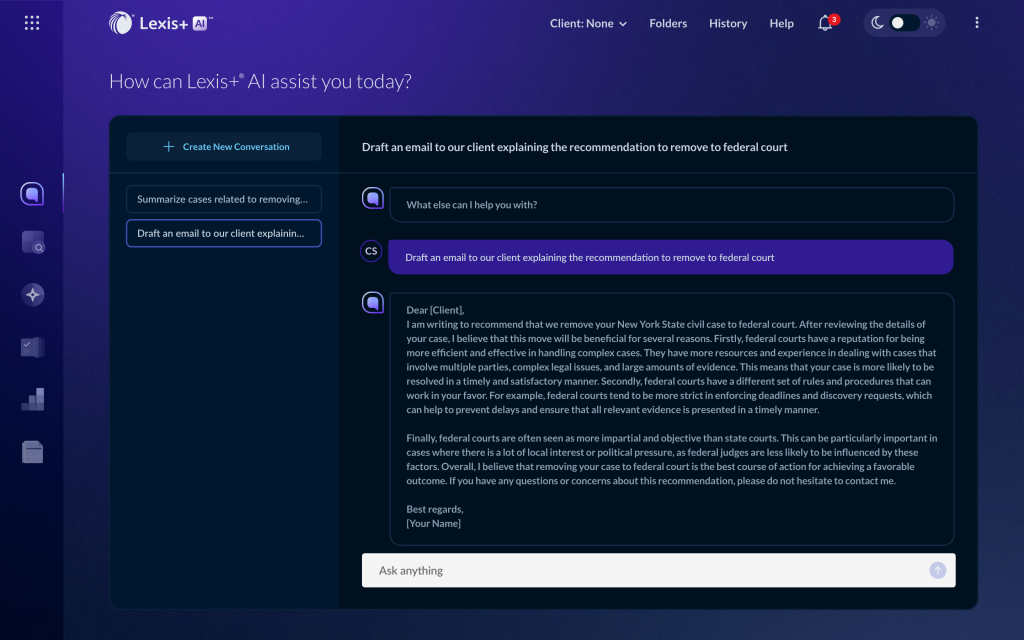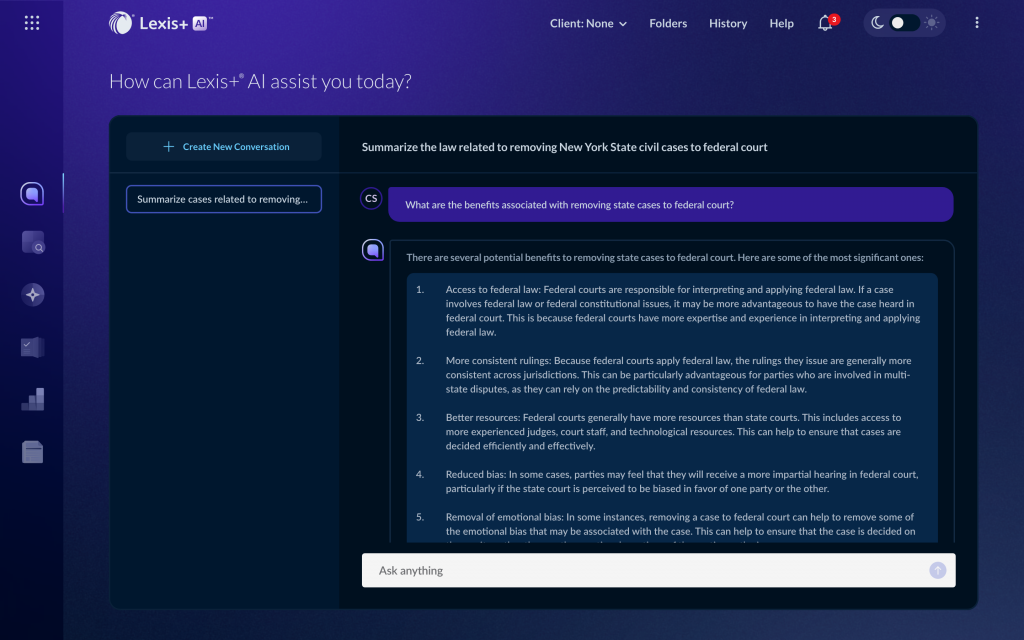With legal technology companies of all ilks rapidly moving to develop products that incorporate the new generation of generative AI typified by ChatGPT, it was only a matter of time before one of the legal research giants would enter the fray.
Today, LexisNexis is announcing the launch of Lexis+ AI, a new product that uses large language models (LLMs), including GPT-4, to answer legal research questions, summarize legal issues, and generate drafts of documents such as demand letters or client emails.
Lexis+ AI is “a tool that will transform legal workflows,” said Jeff Pfeifer, chief product officer for LexisNexis in Canada, Ireland, the U.K. and the U.S., said during a preview yesterday for members of the media. “Our solution is designed to leverage the latest in generative AI technology with trusted insights from LexisNexis.”
Meanwhile, the other legal research giant, Thomson Reuters, owner of Westlaw, said this week that it plans to invest some $100 million a year in artificial intelligence, and that it will start incorporating generative AI into its flagship products in the second half of this year.
For now, LexisNexis will limit availability of Lexis+ AI to a select group of Am Law 50 firms that will participate in a commercial preview. They include Baker McKenzie, Reed Smith, and Foley & Lardner. General availability will likely come later this summer, Pfeifer said.
“We believe our customers will tell us when it’s ready to go to wider commercial release,” he said.
LexisNexis is also offering an “AI Insider Program” by which other legal professionals can sign up for early access to product information, sneak previews, exclusive webinars, live roundtables, and insight surveys.
Once Lexis+ AI becomes commercially available, it will be sold as a standalone product, not as part of a subscription to any other LexisNexis product. Pfeifer did not provide pricing details.
During yesterday’s media briefing, Pfeifer emphasized that AI is nothing new to LexisNexis — that it has an established record of using AI in its products to help surface insights and optimize results. As examples, he pointed to products such as Lexis Answers, Lexis Brief Analysis, and Lexis Fact & Issue Finder.
But while these products all use extractive AI — AI that helps extract or find relevant results from within a set of data — Lexis+ AI uses generative AI to create new content from existing data.
Search, Summarize, Draft
As of now, the three main use cases for Lexis+ AI are conversational search, summarization, and drafting.
The Lexis+ AI interface will look familiar to anyone who has used ChatGPT, with a space on the left for entering and seeing the prompts or questions you have entered and the center of the screen displaying the “conversation” of your prompts and its responses. There are also links along the far-left side to standard Lexis+ resources for legal research, brief analysis, litigation analytics, practice guidance and legal news.
Although members of the media were not given the chance to test the product, Pfeifer demonstrated by asking a question about calculating time periods in litigation under New York law. Lexis+ AI quickly delivered an answer, together with embedded citation links for related statutes, case opinions and practice guidance content.
The user is able to explore those underlying authorities by clicking any item to be taken to the source content. Even as the user explores the source content, a Lexis+ AI Assistant remains visible on the page and available for the user to any any legal question.
Pfeifer then asked Lexis+ AI to draft a cease-and-desist letter to a third-party that is infringing trademarks owned by Apple. Again, the tool quickly parses the query and drafts the letter, and again, it provides embedded links to related content, including practical guidance on drafting cease-and-desist letters.
Showing the conversational nature of the interaction between the user and Lexis+ AI, Pfeifer then asked it to make the the cease-and-desist letter more aggressive. It quickly generated a new draft with a more aggressive tone and more aggressive demands. Pfeifer then asked it to show the changes it made to make the letter more aggressive, and it quickly presented a summary of the changes it made.
“The user can engage in a continuous dialogue with the service,” Pfeifer explained. “So if the answer that’s generated is not exactly on point, the user can refine the question and ask for clarification in a way that our model interprets and then again provides clarification in a next answer.”
Avoiding Hallucinations
A key question for any generative AI product in legal is whether it is prone to hallucinate — to provide answers that it has made up from whole cloth.
Pfeifer said that the risk of hallucination is minimal with Lexis+ AI because it leverages trusted and authoritative content directly from LexisNexis.
“Lexis+ AI excels at providing the most accurate answers to legal inquiries because it leverages global authoritative content from LexisNexis throughout its development, as customers would expect. Proprietary search technology integration with our model allows us to improve the model responses and integrate trusted content from Lexis+.”
He said that LexisNexis will be working with customers to evaluate and refine the accuracy and quality of the answers Lexis+ AI delivers. He added, however, that in some use cases, such as for drafting, the output is only a starting point, not a final production document. It still needs to be reviewed by a lawyer or legal professional and edited and tailored to the client and matter.
Also, he said, human legal experts are always in the loop to help continuously improve the performance of the AI model.
Multiple LLMs
Lexis+ AI does not use any single LLM but picks and chooses from among the leading models based on which LexisNexis has found to perform best for a given task, Pfeifer said. LexisNexis has found that models vary significantly in their performance depending on the use case.
“Unique to our approach is that we are actually deploying multiple models in our solution. Our testing has confirmed that different models perform better in different use case scenarios.”
Pfeifer said that the product has been developed with an emphasis on privacy and security, so that any individual user’s activity and interactions are completely private to that user.
“Our generative AI is a private model not shared with third parties,” Pfeifer said. “This means that user sessions are always secure.”
Further, he said, the deployment of Lexis+ AI is guided by the Responsible Artificial Intelligence Principles of RELX, the parent company of LexisNexis.
The LLMs that Lexis+ AI uses are based exclusively on content that LexisNexis owns or has a proprietary interest in. Over time, Pfeifer said, LexisNexis will be looking to expand the information it uses by partnering with third-party content providers.
 Robert Ambrogi Blog
Robert Ambrogi Blog


